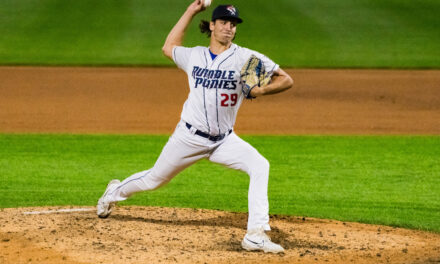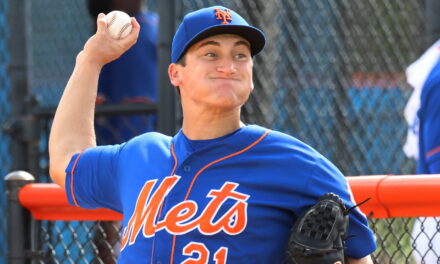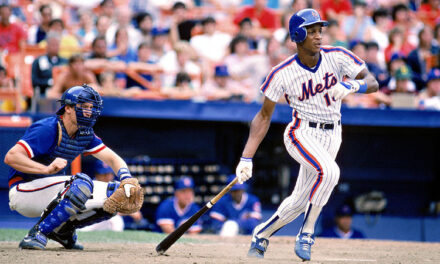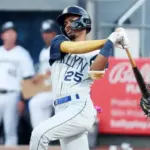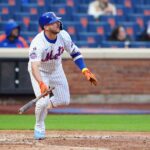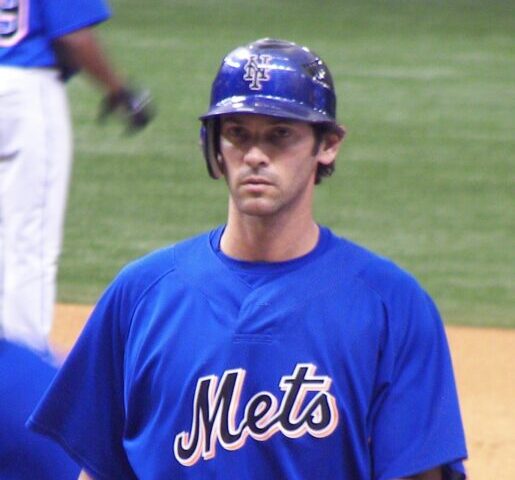
When fans think back to the prolific power hitters of the late 1990s to early 2000s, many might overlook Shawn Green.
The slender left-handed hitter might not be the first slugger you think of when looking back at that era, yet Green hit the 11th-most home runs from 1998-02 with 192.
Green, 47, was a two-time All-Star, Gold Glove-winning outfielder who hit more than 40 home runs three different times (1999, ’01, ’02). He set the Los Angeles Dodgers’ single-season record for homers with 49 in ’01 and holds the single-game record for total bases with 19, which he set on May 23, 2002, when he went 6-for-6 at the plate against the Milwaukee Brewers on the road.
Among all-time players, Green is one of 25 to hit at least 325 homers, steal 150 or more bases and record a career OPS+ of 120 or better. Green is one of eight players (nine times total) to post a season with 45+ homers, 20+ stolen bases and an OPS+ of 150 or greater which he accomplished in 2001, his second year with the Dodgers.
The New York Mets acquired Green on August 22, 2006, as the veteran outfielder waived his no-trade clause to help the Mets’ beleaguered outfield situation after dealing Xavier Nady to the Pittsburgh Pirates at the trade deadline and placing Cliff Floyd on the disabled list earlier in the month.
In 34 games down the stretch, Green slashed .257/.325/.442, with 13 extra-base hits and 15 RBIs. In 37 postseason plate appearances in ’06, Green hit .313 with three doubles, four RBIs and four walks. His .429 OBP in the N.L.C.S. against the St. Louis Cardinals was the second-highest on the Mets among players with at least 20 plate appearances.
The 2007 season would be Green’s final year in the majors, as he posted a 103 OPS+ with 41 extra-base hits in his age-34 season with the Mets. While Green reflects back and supposes he could’ve played a few more seasons, the opportunity to be home and watch his two young daughters grow was well worth calling it a career.
After spending 16 years in professional baseball, Green turned his attention to another passion: technology.
Green’s interest in tech traces back to his youth growing up in California and watching the rise of Apple. Throughout various spring trainings, Green would make it a habit of trying to learn new programs like Final Cut Pro, PhotoShop and FileMaker.
In 2014, Green, along with his cousin Daniel Kirschner, founded Greenfly, a content collaboration and distribution engine that has partnerships with Major League Baseball, Showtime and the World Surf League to name a few.
In MLB, players that have the Greenfly app can come off the field after a game and access the content that was taken. That content can then be used at the players’ disposal to be shared on their social media accounts, which Greenfly tracks as well.
With MLB looking for ways to help better market and increase the visibility of its players, the Greenfly app helps aid in that quest and puts the content right in the players’ hands.
Green’s transition from the diamond to entrepreneur is a compelling story of a man who has taken his two passions and has seen success in both.
From belting homers with such a smooth, effortless swing for fifteen seasons, to breaking into the tech scene, Green has continued to swing for the fences with each and every one of his endeavors.
I had the privilege of speaking with Green in early June, where we discussed his six-hit, four-homer game, his time with the Mets and founding Greenfly.

MMO: Who were some of your favorite players growing up?
Green: I lived in the Bay Area for most of my grammar school days. I loved Rickey Henderson, that was when he broke the stolen base record.
As I got more into baseball and had the dream of someday making it, I tried to emulate left-handed hitters. I loved Don Mattingly, loved Rod Carew, Wade Boggs; the guys who hit for high averages.
MMO: Who introduced to the game at a young age?
Green: My dad introduced me. He loved sports, still loves sports, and he played college basketball. Baseball and basketball are what he introduced me to the most, and then I played soccer as well as a kid. My dad had a huge impact on my baseball career.
MMO: Prior to the 1991 June Amateur Draft, did you have any idea that the Toronto Blue Jays were looking to select you in the first round (16th overall pick)?
Green: No, but I had a good relationship with the Blue Jays because in California we have scout teams, so I played for the Blue Jays’ scout team. I knew they regarded me highly as a prospect, so I was definitely not surprised when they drafted me.
I was excited to be in the first round, obviously. They were the team that knew me the best at that point in my amateur career.
MMO: You had a breakout year in 1998 with the Toronto Blue Jays, playing in a then career-high 158 games with 35 homers, 35 stolen bases and an .844 OPS. Both your home run and stolen base totals were more than double from your previous career bests.
In your book “The Way of Baseball,” you describe some terse moments between yourself, Cito Gaston (manager) and Willie Upshaw (hitting coach) about your playing time and how they wanted you to pull the ball more. Do you attribute the tee work you put in during the ’97 season as a big reason for your marked improvements at the plate?
Green: Yeah, I think there were three big factors. One was the situation that brought me to my tee work and then learning how to make that a daily meditation and put more attention into the details that went into that. That was a huge part of it.
Another huge part of it was playing for a manager [Tim Johnson] that wanted me in there, put me in the top of the lineup and got a chance to play every day. Playing every day definitely added to the totals.
I think the third factor was playing with Carlos Delgado, as I talked about in my book as well, and having this Home Run Derby game that we sort of stumbled upon in batting practice to try and drive the ball to center field as far as we could and making it a competition. That was a true factor that kind of changed my trajectory as a player.
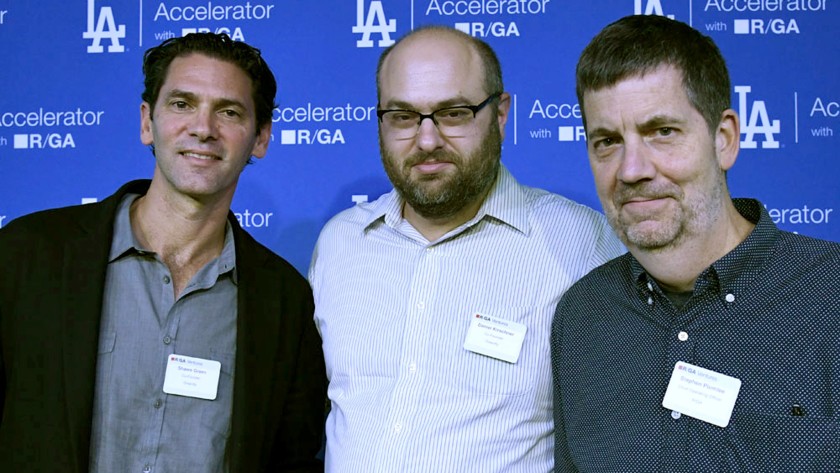
MMO: You brought up meditation. In your book, you write about how meditation was a key component for you and how you studied Eastern philosophies during the early part of your pro career. You wrote that it helped you develop a more “meditative approach to the game of life.” Can you talk about how meditation aided you not only on the field but off it?
Green: I was always a spiritual seeker in the Eastern philosophies and books around that were what I gravitated towards. I saw baseball as such a great arena to learn about yourself and to learn about life. I felt the two sort of played off each other. For me, I learned more and more about life and I also wanted to become a better baseball player.
I think looking into these Eastern philosophies and baseball just paired really well, and that definitely had a huge impact on both my life and my playing career.
MMO: After being traded from the Blue Jays to the Los Angeles Dodgers in November 1999, was there any added pressure with signing that six-year extension?
Green: Yeah, of course. I really only had two years leading up to that to justify a big contract, but I was definitely in a prime age of my career. To come home, go to a big market, and all of a sudden be expected to live up to a large contract – and also be an anchor in a lineup that expected to go to the postseason on a regular basis – yeah, I felt a lot of pressure.
It was a challenging transition the first year especially. I think it’s easier to sign a big contract in the place where you earned that contract in a lot of ways because the fans already know you and they understand why you’re getting that, along with the organization and your teammates.
Here I am going from a different league, and not only a different league but a league with teams I’ve never played against before in the N.L. West. I think it was definitely a big challenge.
The other thing that was kind of strange about it for me was the offseason where I lived in California felt like a different part of my life than my in-season in Toronto. All of a sudden, I’m merging those two worlds and I think that took a few months to get used to. Waking up in my own bed saying, ‘I’m going to the stadium now’ felt like it should’ve been the offseason that whole first year, which was kind of a strange adjustment as well.
MMO: Can you expand a bit on how big a transition it is to go from one league to another?
Green: It’s a big impact. I already played five [full] years but I felt like a rookie again because you go to St. Louis, Cincinnati, all of these ballparks and cities. And you don’t know the cities, you don’t know where to go into the stadium, you have to have a veteran player with you to say, “Okay, this is where you pull up in the taxi.”
There are a lot of things that just change your mentality and you don’t feel comfortable. And in baseball, so much of it is feeling comfortable and confident and all of sudden that was all uprooted.
I think that was a big part of it and then knowing the pitchers. There are pros and cons because they don’t know me, but I relied a lot on looking for pitches and knowing how guys wanted to throw to me. It’s like starting from scratch at that point.
MMO: In your book, you write that you kept detailed notes and tracked the pitchers you faced. When did you initially start jotting these notes down and how would you utilize the information you were logging?
Green: I probably started my first few years, but I really didn’t know how to take notes the right way. I was just kind of keeping track of pitches.
I realized what worked for me the best: I wanted to go up there and use the right side of my brain and be more in the zone and in the flow, and less in the left side where it’s more analytical and statistical. It’s like saying he threw me a fastball 1-0 or whatever; that sort of got too analytical and I felt like I was overthinking.
I would say it was probably around ’98 when I started to understand the type of data tracking and how pitchers pitched to me. That’s when I started to find the sweet spot and know if I got into a hitter’s count throughout the day against this pitcher, I’m going to look for changeups. Or, if I get behind in the count he’s going to try to throw that fastball inside and freeze me.
Those were the types of things I wanted to know as opposed to first pitch give me a lot of fastballs, second pitch, etc. It’s a matter of knowing what works for you as a hitter.
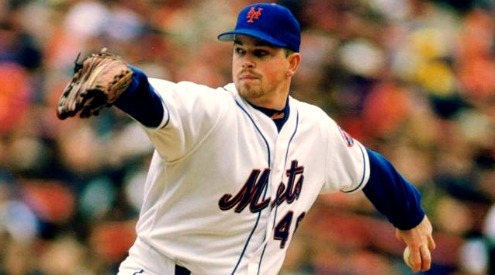
MMO: May 23, 2002: You had one of the greatest offensive performances in a single game with six hits, four homers, five extra-base hits and seven RBIs in the Dodgers’ 16-3 win over Milwaukee. Can you talk about that game and how you felt during those at-bats?
Green: After recording the single-season record of 49 home runs for the Dodgers [in 2001], I was a quarter of the way through the season and I had three home runs going into Milwaukee. I was in a huge slump and I was getting booed at home for the first time.
We played the Mets and Expos on a homestand and I was 0-for-my-first-18 of the homestand and was getting booed for the first time. They take a little longer to start booing you in L.A. than they do in New York, so I was feeling the pressure there.
I hit a double against the Expos in my last at-bat of that homestand, so it at least broke the 0h-fer for me. Then we head to Milwaukee and I had been working on a lot of things and kept trying to tone my swing down and not be so overanxious and all that.
The first game in Milwaukee I hit two home runs and then the next day I hit a triple, so all of a sudden I was like okay, I’m finally finding it. And then that next day, I wouldn’t say I was locked in walking into the stadium, but I felt like now I’ve finally found my timing a little bit so I didn’t feel as stressed out as I had the previous six or seven weeks of the season.
The first at-bat I battled and with two-strikes squeaked a groundball down the first base line for a double. Any time you do that against a lefty (Glendon Rusch was pitching for the Brewers) as a left-handed hitter it kind of takes the load off.
I knew he’d come in after throwing a slider away so I felt like he was going to throw me a fastball in, and I just got enough of it and that was the worst of the home runs I hit, but I hit it out to right field [in the second inning].
Then a righty came in, a rookie who I’d never seen before (Brian Mallette), but he hung a slider and I hit it to right-center [in the fourth]. And then it got easier and easier because now at this point I’m feeling really dialed in and I already have two home runs and a double. At this point I knew he’d go away because I hit the slider to right-center field and the next one I hit a fastball away – I was just looking for a pitch that I could hit hard and he threw it right where I wanted it – and hit it out to left field [in the fifth].
At this point, I’m trying to get to a fourth. The next at-bat I hit a single; Jose Cabrera came in and that was probably the hardest ball I hit that day. It was low, about shin-high and I couldn’t elevate it but I hit a line drive up the middle.
Then the manager Jim Tracy said, “Why don’t you go shower.”
He was just relieved that I was out of my slump and driving the ball to all fields and I said, ‘A couple of guys could get on. Let me take another crack at a fourth home run.’
So, I went out there and sure enough with two outs [in the ninth], Adrián Beltré hit a home run to give me a shot at it.
A funny little piece to that story was that the Brewers had a promotion that a fan could pick a player for the cycle and that fan would win a million dollars. Some fan picked me that day and you don’t know this as a player and I didn’t even know there was a promotion. Had I missed home plate after my fourth home run, if I had known, then she would’ve won a million dollars. Isn’t that crazy?!
What’s crazy is that it kept going and the next day the first at-bat I had against Curt Schilling in Arizona I hit a home run and then I had two more hits. I actually almost hit another home run but it was a sac-fly caught deep in right. Then the next game I had two more home runs so it was just this crazy streak that went from being 0-for-18 the week before, to all of a sudden having the best week I think anyone has ever had. It was pretty crazy.
MMO: What were your initial reactions when you were dealt to the Mets from Arizona in August 2006?
Green: That was something I had the ability to block, but I was excited about the opportunity! When I left L.A. at the end of ’04, they asked me to waive my no-trade. At that point with new ownership and a new general manager, I was like, If you don’t want me here then I’ll move on.
So I went to Arizona and I was a little fried I think just from a lot of the ups and downs and a lot of changes in the organization. I just think I needed a change, I was kind of happy to go to a smaller market at that point.
After a year and a half of that, when I knew that the Mets were looking to make a trade, I was pretty excited about the opportunity to dive back into the fire and be on a good team with a chance to win a World Series and play in the biggest market.
I accepted the trade and I also had a lot of friends on the team: I played five years with Paul Lo Duca, a bunch of years with Guillermo Mota and eight years with Delgado at that point counting the minor leagues.
I had a lot of guys that I felt comfortable with as soon as I walked in the clubhouse and everyone was very welcoming when I got there.
MMO: Can you compare and contrast the differences between playing in Los Angeles vs. New York?
Green: They are very different in that New York is one of a kind. There are other cities that have that intensity, more on the East Coast like Boston, obviously New York, and places like Philly which is known for being even more challenging to play when you’re struggling.
New York has the intensity of the fans and just the love for the Mets. Of all the places I’ve played, that was for sure the most intense.
I had a great time everywhere, but I would say for me, L.A. was home. It was a more laid-back kind of vibe as you’d expect in California. You’d get in heated games against the Giants or you’d get into the postseason or down to the stretch the intensity is a lot more. But it’s not like New York where you’re in the postseason and the fans are on their feet most of the game.
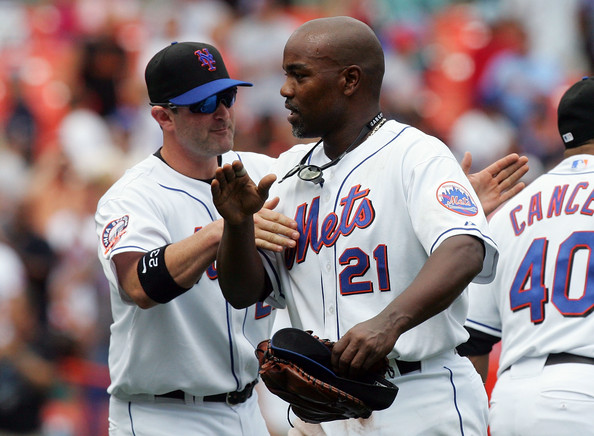
MMO: You’ve mentioned Carlos Delgado several times throughout our discussion, and I know you’ve been a vocal proponent that he should’ve garnered more love from the writers for the Hall of Fame (which I agree with). To you, what made Delgado so great?
Green: There are a lot of things about Carlos. I haven’t played with anyone smarter than Carlos, not just in baseball but just a really intelligent person on and off the field. He’s the type of guy that just remembers details about everything and for me, he was kind of like a big brother.
We roomed together one of my first springs in Dunedin and he cooked food for both of us and taught me how to do my laundry. He was really like a brother in that regard. I learned a lot about hitting, how to hit for power.
The thing about Carlos that I think is really special for a team is he speaks perfect English and perfect Spanish and brings the Latin players and the American players together. He’s the connective tissue. I played with a couple of guys that were like that and I think that’s crucial for team chemistry because some teams you just have the Latin players on one end of the locker room and the Americans on the other end, and you might have a couple of players from Japan or Korea that trickle in as well.
To create that cohesion, you need a guy like that. Another guy that was like that was Adrián Beltré. But you want some guys that are going to set up a dinner and you’re going to have half the guys speak Spanish as their first language and half the guys speak English, and that’s pretty crucial for chemistry.
MMO: The 2006 National League Championship Series was the closest you ever came to reaching the World Series during your 15-year major league career. Can you elaborate on that N.L.C.S.?
Green: It was a good series. It was one of those things where anytime you go seven games you feel like you could point to different games or moments that could’ve gone the other way and we would’ve won. I felt like based on our record that season we had the better team. I think El Duque getting hurt was a big blow to us. At that point, our strength of the team in the postseason was the bullpen and our lineup.
I think with El Duque down and Pedro Martinez being hurt as well most of that season, that was the tricky part. But John Maine and Oliver Perez really stepped up big in that series and pitched well. And Tom Glavine was always super reliable, you know you were going to get a quality start from him.
That El Duque injury, he was so clutch in the postseason that it’s too bad that didn’t work out for us.
MMO: The 2007 season was your final year in the majors, as you decided to retire in February 2008. Had retirement been on your mind for some time, or did that come about more so during the ’07 season?
Green: It’s something I had debated for a period. For me, the lifestyle was what was starting to get to me. I always loved the game but I had two daughters and my older daughter was about to start school. Just moving around the country all the time and then having to go to spring training on the East Coast, and then obviously when I’m home during the season it’s like home one week, gone a week. That was what was weighing on me.
Looking back, maybe I should’ve played a couple more years. I definitely don’t regret any of the time that I had watching my kids grow up, but I think when you’re in it the thought of being away from family for a month or two at a time during different parts of the year was a bit much for me and that’s why I stepped away.
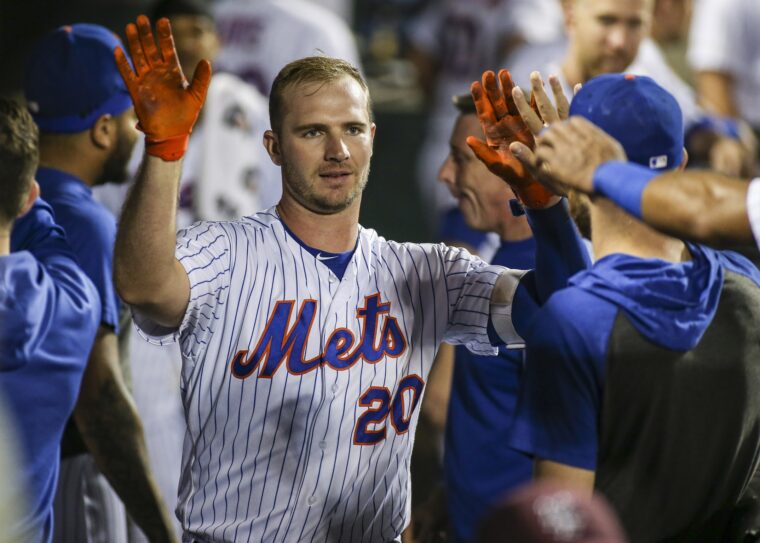
MMO: Talk a bit about co-founding Greenfly. When did this idea come about for you and what’s the company all about?
Green: I started it about seven years ago. I built a working prototype and at the time it was a video Q&A platform. I was still getting requests for videos to get sent in or whatever, to talk about different things in my career that were relevant to what was going on in the game at that time. I thought it would be cool to have a platform where you can just get a request from a broadcast partner or team and say, let’s talk about what you did in 2002, and get a video request and just do it all seamlessly through an app.
I built that and brought in someone to run the business who is my co-founder, Daniel Kirschner. We’re actually first cousins and he had recently moved out to L.A. to be an executive at Activision Blizzard. He got excited about it and came in about six years ago and he turned it into a real business. We did the full fundraising, different rounds of funding, and brought in a large team to build the product for real.
We’re a true technology company and now what we are is we’re not just requesting content, but it’s a platform for sports properties, brands, media companies, non-profits to collaborate with their advocates.
So, in baseball, I think over 600 players now have our app on their phone and all the photo content and a lot of video content run through our platform. When players get off the field they’ll have their photos and highlights and things from the games.
I know there’s an article about Pete Alonso where he talks about how he logs in and his mom gets the content as well, and whatever they share on social our system tracks it too. So the league and the team will know that Alonso downloaded this photo, shared it and this is how it did on Instagram and it got this many likes and different things like that. We track it all.
It’s kind of a two-way platform getting content out through the advocates to share and then pulling in content from them for the brand, team and the league to repurpose and maybe add animations or create promotional materials and share it on whatever channels they choose.
MMO: And how did the MLB partnership come about?
Green: It’s something where we met with them and they loved it and they’ve been using it now for about three or four years. The players being on board has been in the last year-year and a half and that kind of caught on like wildfire.
At first, it was a way to just move content between the capture content in all the games and have it all fall back to the league and the teams. It was sort of a back-end infrastructure for the movement of content around each game and then they added the players to the mix and allowed them to get access to their own personal galleries.
MMO: Was technology something you always had interest in?
Green: I always loved tech. In spring training I’d always get the plan to learn a new skill. One year I wanted to start learning how to code, and I’d get through a chapter and I got so mentally drained in spring training that I’d never quite get far in it. I did get a little further learning to do stuff like Photoshop, Final Cut Pro and FileMaker for database; that’s what I actually used to track my pitchers and keep information for my career.
I was always trying to learn more because I love technology. I grew up in San Jose until I was 12 and with the rise of Apple, it was something that I was always really intrigued with.
MMO: What’s in the pipeline for Greenfly?
Green: We’re expanding a lot internationally. We work with almost 20 leagues of different sizes like the World Surf League. It’s cool for them because we have a partnership with this company called WSC that does all these AI automated highlight clips in different sports. So with World Surf League, when they get out of the water if they score above a certain score they’ll automatically trigger that highlight clip to go right into their Greenfly personal galleries. All the better rides will get automatically served up to surfers.
We do a lot in sports and lately, since COVID-19, we’ve been doing also a lot in what we call Greenfly for Good. We’re doing a lot in the International Red Cross and organizations like that, and they’re using us to collaborate in their different countries and different regions with their different offices for the movement of content and distribution of content.
We do a lot in entertainment with media companies; most of the major media companies in the U.S. we work with. A lot of times they’ll use it to distribute content to their talent, tune in for this or a lot of times they’ll have them create videos.
We’re kind of across the board and nowadays everyone is trying to collaborate with advocates on the creation and sharing of content across different social channels. We’re kind of like Slack, which is a tool a lot of companies use to collaborate on with their employees. We’re like that type of tool but for content and social collaboration.
MMO: When you look back on your playing career, what are you most proud of?
Green: That’s a good question. I think I’m most proud of the fact that I played the game the right way. I was never tempted to go down the path of performance-enhancing drugs, never chewed tobacco. I just kept my nose clean and wanted to just go out there and do things so I can always feel proud to tell my kids and parents: This is how I played the game.
That’s something I’m most proud of.
MMO: Thanks very much for some time today, Shawn. Best of luck with Greenfly.
Green: My pleasure, thanks.
Follow Shawn Green on Twitter, @shawngreen15
Follow Greenfly on Twitter, @greenfly
Visit Greenfly’s website here.


